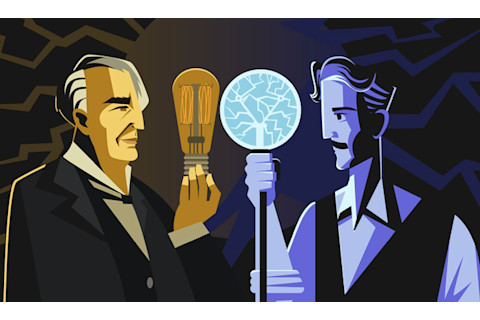Nikola Tesla: Genius, visionary, inventor extraordinaire! What did he invent? Why, only the Era of Electricity, developing the very power system that still lights the world today. Oh, and also radio, X-ray imaging, radar, remote control, death rays and wireless communications with other worlds.
Well … that’s if you believe the hype once generated by the man himself, amplified by the media of the early 20th century, and perpetuated today by legions of admirers.
What Did Nikola Tesla Do?
Even 80 years after his death, Nikola Tesla (1856-1943) is still revered — possibly more so than he was in life — as a rock star of the science world, his name elevated almost to the same dizzying heights as Newton, Curie or Einstein. Even Discover staffers are not immune to the Tesla mystique: After all, we put him smack in the middle of our own list of the greatest scientists ever.
Read More: The 10 Greatest Scientists of All Time
Today, Tesla fans the world over still see him as both hero and martyr, nemesis of the mighty Thomas Edison, tireless engineer of progress, and prophet of modernity whose reach often exceeded his grasp. That Tesla possessed a towering intellect and a dazzling view of the future cannot be disputed. But neither can the fact that he was also a born showman and inveterate self-mythologizer.
Taken together, those qualities make it difficult sometimes to separate truth from myth. But here are the facts we do know that debunk — or at least clarify — a few of the most persistent legends about the man.
What Did Nikola Tesla Invent?
Lots of stories about Tesla credit him for inventing the first alternating current (AC) motor or sometimes even AC power itself. To be sure, the development of AC electricity was world-changing. AC outmatched direct current (or DC, championed by Edison) and its eventual acceptance paved the way for cheap, reliable, widespread electricity in an era illuminated by candles and gaslight.
But the assertion that Tesla invented the whole thing is wildly — we might even say shockingly — inaccurate. In 1888, Tesla did develop and patent an AC motor, but he wasn’t the first. Plenty of scientists and engineers had worked on generating AC power — the earliest known generator dates at least to the 1830s.
Polyphase AC Motor
Less hyperbole-prone Tesla scholars and fans will clarify that Tesla’s great innovation was to create a polyphase AC motor, which could produce more power more efficiently and consistently than earlier single-phase systems (and more so than the DC system that Edison was pushing). But even here, Tesla wasn’t the first. Many historians assert that Italian physicist Galileo Ferraris first developed such a polyphase motor, but graciously allow that Tesla (and others) may have arrived at similar breakthroughs independently.
Certainly, Tesla saw the potential for the motor and was quick to patent his. Moreover, his demonstration of the motor to a group of engineers was what first attracted the attention of George Westinghouse — Edison’s real adversary in the War of the Currents that would unfold when the primacy of AC over DC power was still in question. Westinghouse bought Tesla’s motor patent and together they would begin advancing AC power as the dominant form of electricity, notably with the 1895 installation of a hydroelectric power plant at Niagara Falls.
The Famous Tesla Coil Wasn’t Unique

A promotional image of Tesla in his lab, with one of the largest coils of that time. (Credit: Dickenson V. Alley (colorized)/CC BY-SA 4.0/Wikimedia Commons)
Dickenson V. Alley (colorized
While it’s true that Tesla patented his eponymous coil circuit in 1891, others were experimenting with similar devices before then — Elihu Thomson, for example (he and Edison would eventually co-found General Electric). But as with his polyphase AC motor, Tesla is credited with seeing many potential applications for the coil, including generating high-voltage electricity, sending and receiving certain kinds of radio waves, and even leading to the possibility of wireless lighting.
Sold Out Lectures
It didn’t hurt that the Tesla coil also made one heck of an impression when you switched it on, and Tesla used his device to full effect at various public demonstrations in the 1890s. These presentations made the man famous: His lectures were sold out and for most of the rest of his life he would be something of a media darling.
What’s more, the theatrical effects of the larger versions of this lightning-spitting coil would reverberate well into the next century. In the golden age of Hollywood horror and monster movies, it was practically a law that any set dressing of a mad scientist’s lab had to include Tesla coils. You can still find them attracting outsized attention at many museums and science centers.
Nikola Tesla vs Thomas Edison

(Credit: delcarmat/Shutterstock)
delcarmat/Shutterstock
Thanks to movies, books and even popular comics, you’d be forgiven for thinking that Tesla and Thomas Edison were archenemies on the level of Superman and Lex Luthor. There was indeed a dramatic and sometimes bizarre struggle to determine whether DC or AC would be the dominant form of electricity to illuminate the world. However, that conflict had as much to do with business rivalries as it did with science, and Edison and Westinghouse were its main adversaries.
Read More: Edison’s Cruel Quest to Show the Dangers of Alternating Current
Here's the real lowdown on the relationship between the two: Tesla and Edison certainly knew each other — Tesla even worked for Edison briefly, then left to pursue his own interests, including AC power. But far from being combatants on opposing sides of the electricity camp, historical accounts paint a different picture of the two men, one of mutual respect.
In no less an institution of record than The New York Times, Tesla lauded his former boss’s “great genius and undying achievements.” Meanwhile, Edison once referred to Tesla as “one of the greatest electrical geniuses the world has ever seen.” Hardly the words of sworn enemies.
Now You Know What Nikola Tesla Is Known For
In the end, maybe Edison deserves the last word on Tesla. Like so many great minds and agents of change, Tesla’s real claims to science immortality shouldn’t depend on whether or not he invented something wholly new. What matters is that his innovations — and his inexhaustible enthusiasm to promote their uses — advanced human progress, while his life and legend continue to inspire new generations of makers and thinkers.
Read More: How the U.S. Could Have an All-Renewable Energy Grid















